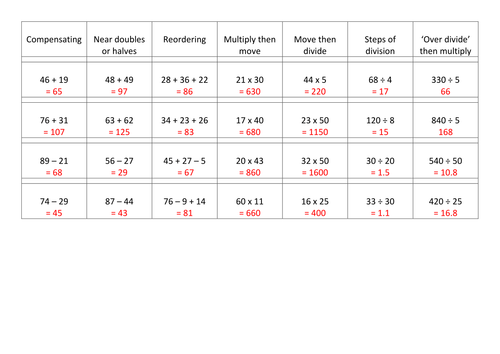

A card sort activity for pupils to sort into groups based on the most suitable mental strategy for answering the question. Of course pupils can then answer questions (answers are provided on the second sheet). Just for clarity in the terminology, the strategies given are as follows:
Compensating - adding or subtracting a value near the one suggested and then compensating for the change, i.e. calculating 34 - 19 by doing 34 - 20 + 1
Near doubles or halves - adding two numbers that are near each other by doubling a number and the adjusting as necessary, or subtracting one number that is nearly half the other in a similar way i.e. 34 + 35 = 35 x 2 - 1 (or 34 x 2 + 1); 45 - 23 = 46/2 - 1 = 22.
Reordering - Reversing numbers in a sum to make use of bonds i.e. 28 + 36 + 22 = 28 + 22 + 36 = 50 + 36
Multiply then move - Separating a multiplication where one of the values is a multiple of 10, 100 etc so that a multiplication is done, followed by the moving of a number in columns i.e. 23 x 30 = 23 x 3 x 10 = 69 x 10
Move then divide - Similar to above, when dividing by a multiple of 10, 100 etc, move the number first and then divide by what is left i.e. 44 x 5 = 44 x 10/2 = 440/2 = 220.
Steps of division - Completing a division in multiple steps i.e. 120 ÷ 8 = 120 ÷ 2 (=60) ÷ 2 (= 30) ÷ 2 = 15 or 30 ÷ 20 = 30 ÷ 10 (=3) ÷ 2 = 1.5.
'Over divide' then multiply - when dividing by a factor of 10, 100 etc, divide by 10, 100, etc then multiply by the complementary factor; i.e. 420 ÷ 25 = 420 ÷ 100 x 4 = 4.2 x 4 = 16.8
Compensating - adding or subtracting a value near the one suggested and then compensating for the change, i.e. calculating 34 - 19 by doing 34 - 20 + 1
Near doubles or halves - adding two numbers that are near each other by doubling a number and the adjusting as necessary, or subtracting one number that is nearly half the other in a similar way i.e. 34 + 35 = 35 x 2 - 1 (or 34 x 2 + 1); 45 - 23 = 46/2 - 1 = 22.
Reordering - Reversing numbers in a sum to make use of bonds i.e. 28 + 36 + 22 = 28 + 22 + 36 = 50 + 36
Multiply then move - Separating a multiplication where one of the values is a multiple of 10, 100 etc so that a multiplication is done, followed by the moving of a number in columns i.e. 23 x 30 = 23 x 3 x 10 = 69 x 10
Move then divide - Similar to above, when dividing by a multiple of 10, 100 etc, move the number first and then divide by what is left i.e. 44 x 5 = 44 x 10/2 = 440/2 = 220.
Steps of division - Completing a division in multiple steps i.e. 120 ÷ 8 = 120 ÷ 2 (=60) ÷ 2 (= 30) ÷ 2 = 15 or 30 ÷ 20 = 30 ÷ 10 (=3) ÷ 2 = 1.5.
'Over divide' then multiply - when dividing by a factor of 10, 100 etc, divide by 10, 100, etc then multiply by the complementary factor; i.e. 420 ÷ 25 = 420 ÷ 100 x 4 = 4.2 x 4 = 16.8
Something went wrong, please try again later.
This was a really good resource to help pupils be flexible in their mental arithmetic.
Report this resourceto let us know if it violates our terms and conditions.
Our customer service team will review your report and will be in touch.
£0.00
